Finally bringing colour to Amazon’s eBook reader, the Kindle Colorsoft Signature Edition is for those who enjoy looking at the pretty pictures.
eBook readers survived the arrival of tablets because they offer avid readers a range of advantages. For starters, eBook readers are typically more affordable, plus they’re lighter than tablets and more comfortable to hold in one hand for extended periods.
As an added bonus, an eBook reader’s E Ink screen is easier on the eyes and ensures the device’s battery life is measured in weeks rather than hours.
Of course, the key drawback with E Ink readers is that they rely on monochrome screens. I would argue that this doesn’t matter once you’re engrossed in a good book, but it hasn’t stopped people from asking for colour models.
Kobo beat Kindle to the punch last year with the Kobo Libra Colour and Kobo Clara Colour. Amazon’s first colour e-reader launched soon after, but it’s only recently come to Australia – as both the standard Kindle Colorsoft (sorry, no bonus ‘u’ for Aussie shoppers) and the Kindle Colorsoft ‘Signature Edition’ with a few extra bells and whistles.
The move leaves Australians with a choice of six Kindles. Along with the $199 6-inch standard Kindle, you’ve a range of 7-inch options in the $249 Kindle Paperwhite, $279 Kindle Paperwhite Signature Edition, $329 Kindle Colorsoft and this $449 ($379 at the time of writing) Kindle Colorsoft Signature Edition. Finally, there’s the giant 10.2-inch $529 Kindle Scribe that comes with a stylus.
The Kindle Paperwhite remains the sweet spot in terms of price and features, with the Paperwhite Signature Edition adding $30 to the price tag. In return, you get the addition of an auto-adjusting backlight and Qi wireless charging, as well as doubling the onboard storage to 32 GB.
Likewise, the Kindle Colorsoft Signature Edition offers the same improvements over the standard Kindle Colorsoft, but with a significantly higher $120 premium.
Table of contents
- First impressions
- Specifications and price
- Features
- Reading experience
- Who is the Kindle Colorsoft Signature Edition for?
Kindle Colorsoft Signature Edition first impressions
Before you even open it, you can tell by the size of the box that the Kindle Colorsoft Signature Edition is something special compared to your everyday Kindle. Of course, inside the box it’s mostly empty space to help create the sense of a premium product – a common trick amongst gadget makers.
Like all modern Kindles, you’ll find a USB charging cable in the box, but no AC adaptor. The new colour Kindles feature a USB-C connector, but Amazon has stuck with a USB-C to USB-A cable, making it easier to use an old AC charger lying around the house.
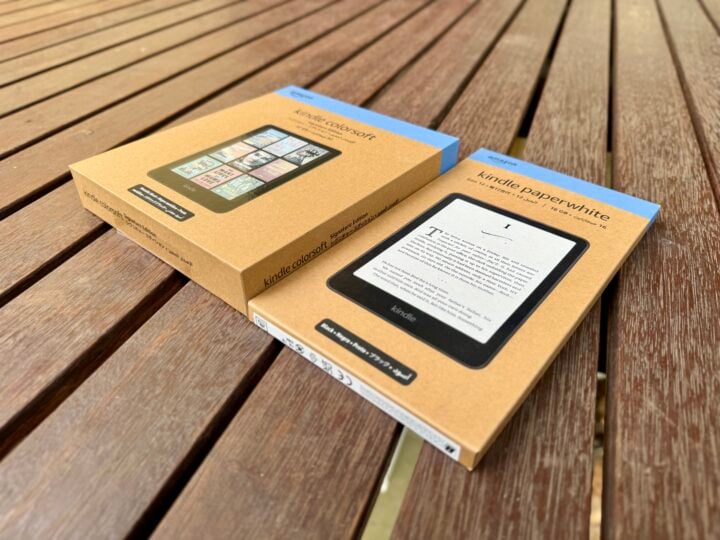
Compared to the standard Kindle Colorsoft, the Signature Edition adds Qi wireless charging. It’s certainly a premium feature, but perhaps it isn’t as useful as it sounds when you remember that you only need to charge it less than once a month.
That said, colour clearly takes a toll on the battery life, with Amazon citing an 8-week typical battery life compared to 12 weeks on a Paperwhite model.
When it comes to overall design, Amazon has retained the standard Kindle layout, with a single power button at the bottom alongside the USB-C port and charge light. There are no page-turning buttons or a full physical keyboard like Kindles of old, as everything is managed via the touchscreen.
Old-school Kindle owners shouldn’t worry too much about losing page-turning buttons. You can swipe your thumb left or right across the screen, or tap the side of the page to move in that direction. Either option quickly becomes second nature, although tapping is only really practical if you’re holding the Kindle in your right hand (assuming you’re reading left to right).
By now, old-timers should have also come to terms with the fact that Amazon’s WhisperNet 3G/4G mobile service was retired long ago. This means you can only access the Kindle eBook store using Wi-Fi, perhaps from your smartphone hotspot when you’re on the move. Amazon also killed off Kindle’s ‘Download and Transfer via USB‘ feature earlier this year, which upset a few people.
The loss of WhisperNet makes onboard storage more important, but doubling the Kindle Colorsoft Signature Edition’s onboard storage to 32 GB is overkill if you’re just reading novels, which tend to be only 2 to 3 MB.
To be fair, colour graphical content such as comics can weigh in at more than 50 MB, so it makes sense to bump up the storage on a colour Kindle.
That extra onboard storage also would come in handy for Audible audiobooks – which take up about 150 MB each – if it weren’t for the fact that listening to Audible audiobooks still isn’t available on Kindles in Australia. You might get lucky if you play around with the location settings in your Amazon account.
Australians can still connect Bluetooth headphones to listen to the VoiceView screen reader, but there’s no headphone jack or built-in speaker.
Kindle Colorsoft Signature Edition specifications and price
| Display size | 7-inch |
| Display resolution | 300 ppi monochrome (16-level greyscale) 150 ppi colour (4096-colour) |
| Display technology | Colour E Ink |
| Onboard storage | 32 GB |
| Charging | USB-C, Qi wireless |
| Battery | A single full charge lasts up to eight weeks – based on a half hour of reading per day with wireless off and the light setting at 13. |
| Wi-Fi | 2.4 GHz and 5 GHz networks |
| Bluetooth | Yes (VoiceView screen reader, no Audible support in Australia) |
| Ruggedness | IPX8 |
| Dimensions | 127.6 x 176.7 x 7.8 mm |
| Weight | 219 gm |
| Colours | Metallic Black |
| Price | $449 RRP |
| Warranty | 1 year |
| Official website | Amazon Australia |
Features
That colour screen is obviously the big talking point, but whether you’d make the most of the Kindle Colorsoft Signature Edition depends on what you like to read.
As someone who owns an ancient 167 dpi Kindle 3, I can say the step up to crisp 300 dpi monochrome displays certainly made text much easier on the eyes. Of course, these days, 300 dpi monochrome displays are now standard across the entire Kindle range.
Likewise, the step up to Paperwhite lighting technology improved the reading experience, and is also now standard on all but the entry-level Kindle.
One bonus feature with the Colorsoft and Paperwhite Signature Editions is an auto-adjusting backlight, inherited from the now-retired Kindle Oasis. It’s a subtle improvement over the standard model, but arguably the most useful.
When the auto-adjusting backlight kicks in, it’s such a smooth transition that you don’t even notice it as you move from outside to inside and then into a darkened room.
So that brings us to the benefits of the colour screen. Keep in mind that, apart from their front covers, most Kindle eBooks are only black and white text. So once you’re lost in a great novel, there’s no difference between holding the $249 Kindle Paperwhite and the $449 Kindle Colorsoft Signature Edition.
Actually, that’s not quite true. Putting a Kindle Paperwhite and Kindle Colorsoft Signature Edition side by side, you can see that the colour of the “paper” and image quality are subtly different.
Open the same monochrome book on the two devices, side-by-side at maximum brightness and zero warmth, and the Colorsoft screen clearly has more of a blue tinge than the Paperwhite. It’s annoying if you’re familiar with the great Paperwhite screen, but after a while, you’d get used to it.
Less forgivable is that, when you look closer, you can see that the Colorsoft display looks more grainy, and black text isn’t as crisp or as high-contrast on the Paperwhite.
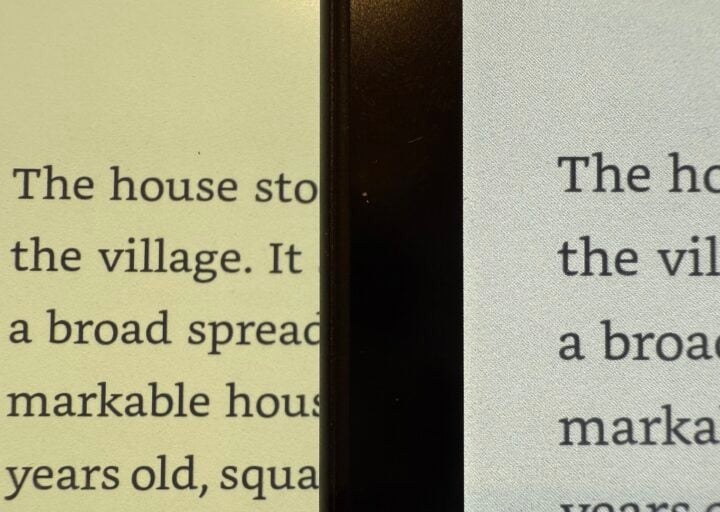
It’s a shortcoming that Amazon freely concedes on the Kindle Colorsoft’s sales page:
“The Kindle Colorsoft display is optimised for reading in colour and is different from the Kindle Paperwhite display, which is optimised for black and white reading.”
“If you are looking for a slightly crisper black and white reading experience, you may want to check out Kindle Paperwhite, which has the fastest page turns and highest contrast ratio of any 2024 Kindle device.”
It’s also worth mentioning that the Colorsoft models don’t support ‘Dark Mode’, which inverts pages to white text on a black background. Instead, it supports ‘Page Colour’, which again doesn’t look as good. All of these shortcomings might frustrate you if you primarily use your Kindle for reading novels.
Looking at the cover art, you can immediately see that the colours are rather muted and images lack fine detail compared to what you’d see on a tablet or in print. You can choose between standard or vibrant colour modes, which doesn’t make a major difference but thankfully doesn’t compromise the quality of the text on the page.
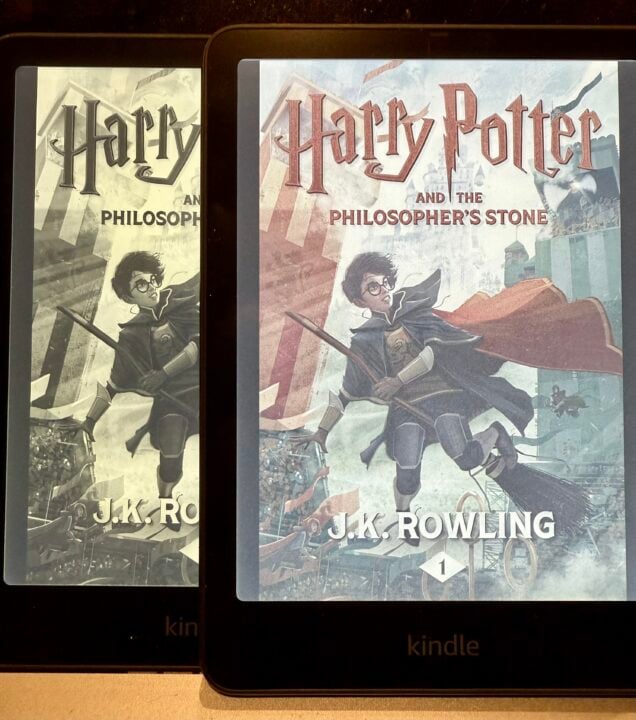
The limited colour palette looks like a style choice, but it’s due to the limitations of Amazon’s colour E Ink display.
Firstly, E Ink isn’t as vivid as a tablet’s screen or a printed book cover. Secondly, Kindle’s Colorsoft E Ink technology is limited to 4,096 colours and only 150 dpi sharpness – which falls well short of the 250+ dpi and millions of colours available on a decent tablet screen or printed page.
This might seem an unfair comparison, but understanding the screen’s limitations helps you appreciate that colour is more practical in some scenarios than others. It’s certainly not worth spending the extra money on a colour Kindle just to glance at a fancy cover before you dive into a book.
Reading experience
One of the most practical uses for colour is the ability to highlight text in four different colours, which you can filter when searching. This could be genuinely helpful if you use a Kindle to study texts.
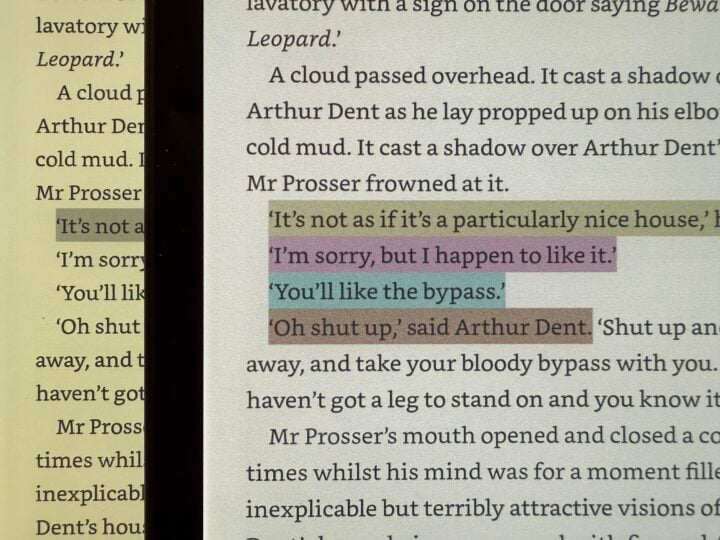
Of course, the primary application for a colour eBook reader is looking at colour images, and that’s where the results are very hit and miss. In short, the nicer the illustration, the worse it looks on the Colorsoft Kindle compared to a tablet or a printed book.
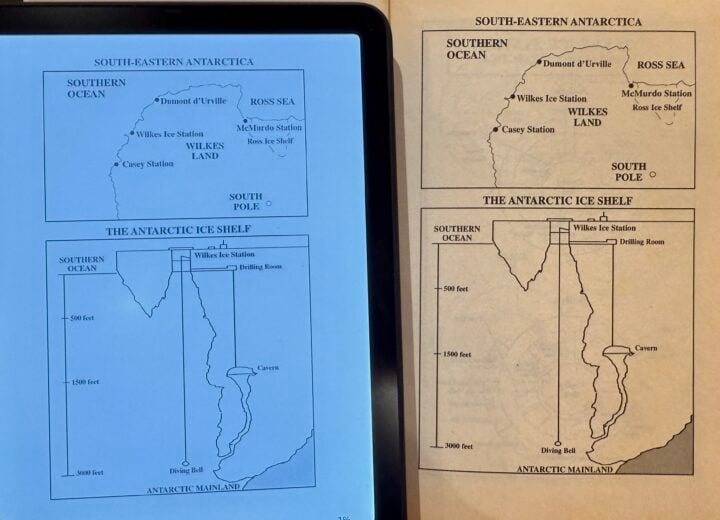
Turning to Matthew Reilly’s Ice Station, the black and white explanatory diagrams don’t look too bad, although the screen is certainly not as clear as the printed page of even a cheap paperback.
Once you start looking around at books with more impressive colour illustrations, the Colorsoft Kindle’s 7-inch screen starts to feel quite small and makes it harder to see the fine details. The Colorsoft’s colours, resolution and contrast also fail to bring to life the majesty of the printed page.
The three books below are different genres and are aimed at different readers, but they have a few things in common. Firstly, the physical books are all larger than the Kindle – which most colour books would be – meaning the images and text are smaller on the Kindle screen than the printed page. Secondly, reading all these books is intended to be a premium, tactile experience.
A beautifully illustrated coffee table-style book like George R. R. Martin’s The World of Ice and Fire is a great example of how the Colorsoft Kindle struggles to match the majesty of the printing page. With something like a coffee table book, the quality of the physical book is a big part of the reading experience.
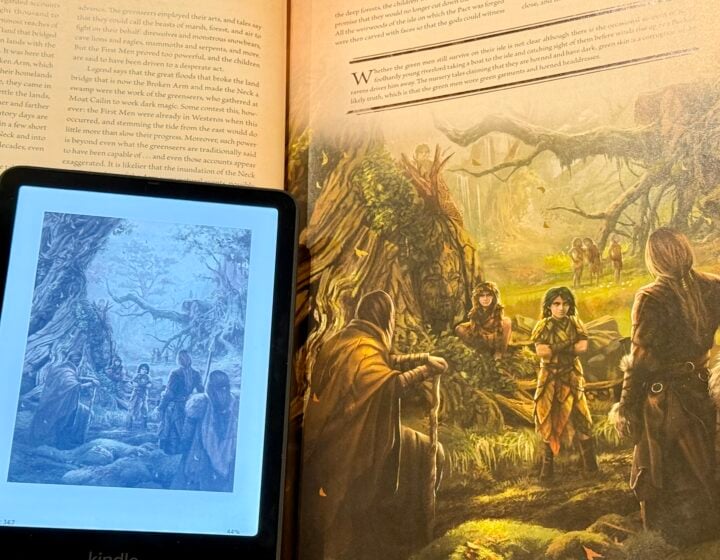
Meanwhile, Jackie French’s Baby Wombat’s Week gives you a feel for reading bedtime stories on the Colorsoft Kindle.
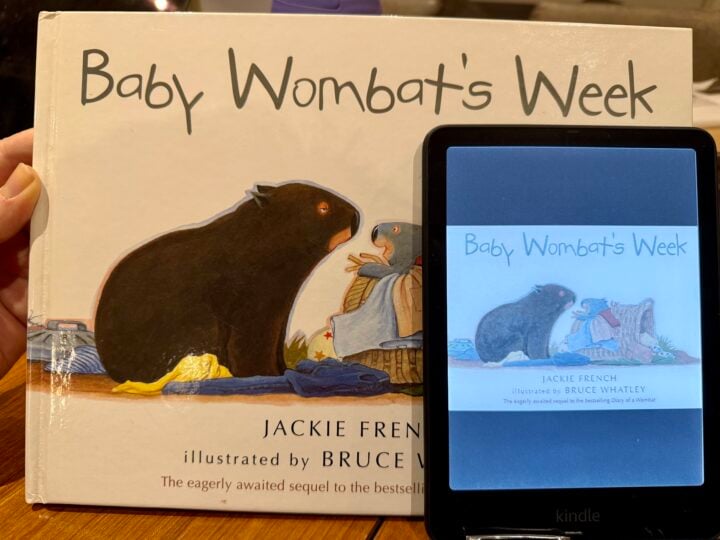
While young children are likely less discerning when it comes to picture quality, reading picture books to them on a Kindle is a rather hollow experience compared to holding up a physical book for them to see and enjoying the ritual of turning the pages. A colour eBook reader might be more practical when they’re up to reading on their own.
That brings us to comics and graphic novels, like Critical Role: Vox Machina Origins, which are arguably the genres best suited to a colour eBook reader.
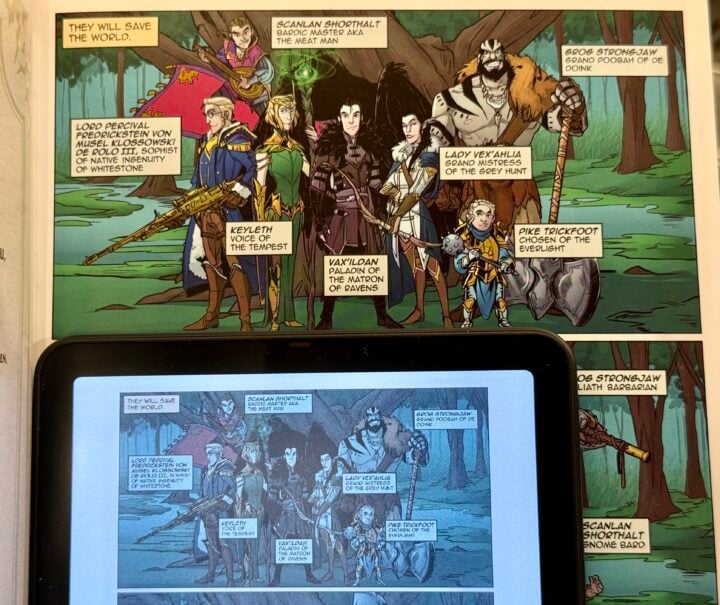
The look and feel of holding the beautiful physical book is lost, but you might be able to put that aside once you become engrossed in a good graphic novel. Yet the screen size also has a significant impact on the reading experience.
Because text on the page is actually part of the images, it can’t rescale independently of the illustrations, so it’s very difficult to read on the Kindle if it’s smaller than the original printed page. You can pinch to zoom in and out on every text block, but that makes for a very cumbersome and disjointed reading experience.
Alternatively, you can enable the Kindle’s panel view by double-tapping in the middle of the screen. This lets you flick through a page’s panels one by one, while making them larger and easier to read. It’s a reasonable compromise, although purists might argue that reading a graphic novel this way ruins the experience.
Unlike coffee tablet books and illustrated children’s books, you’re more likely to tolerate the compromises of the Kindle reading experience if it makes it easier to keep comics and graphic novels in your bag for reading on the go.
Who is the Kindle Colorsoft Signature Edition for?
If you have a genuine need for a colour screen on your eBook reader, then Amazon’s Kindle Colorsoft Signature Edition is probably the one you’ve been waiting for. But, considering the very high price tag compared to the excellent monochrome Kindle Paperwhite, you need to be absolutely sure.
A Kindle Colorsoft is certainly not worth the money if you’d only notice the colour when looking at book covers. Especially considering that, once you’re reading the book, the Colorsoft screen isn’t as crisp as a cheaper Paperwhite screen.
So in order to make the most of a Kindle Colorsoft, you need to be reading books that feature colour illustrations. If that sounds like you, then a colour E Ink screen is great in theory – but the harsh truth is that any book with beautiful colour illustrations worth looking at, probably isn’t worth looking at on the Colorsoft Kindle. Especially when the 7-inch Kindle is probably too small to display the images as the artist intended.
Even in the digital age, reading a beautifully illustrated book is a tactile experience, which is totally lost on the Kindle Colorsoft. Its limited screen size, resolution and colour palette fail to bring colour content to life – something which Amazon might improve with version two.
For now, coffee table books and children’s books are not worth reading on a colour Kindle; you might be more prepared to live with the Kindle Colorsoft’s shortcomings when reading comics and graphic novels on the go.
GadgetGuy occasionally uses affiliate links and may receive a small commission from purchased products.









